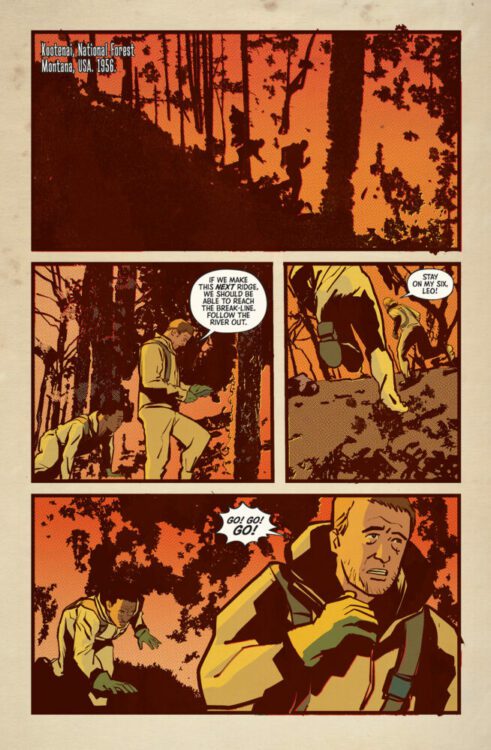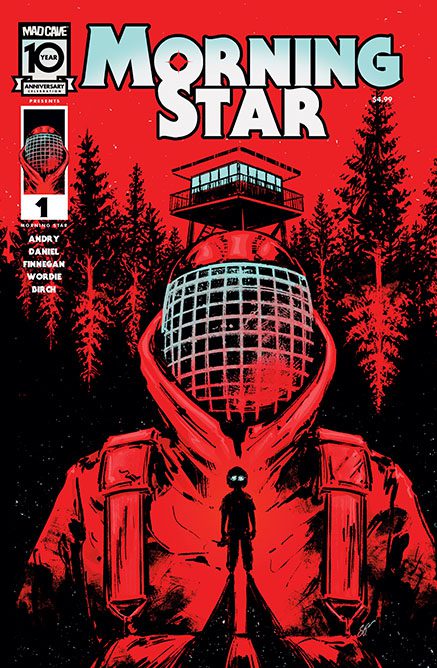From writers Tim Daniel & David Andry and artist Marco Finnegan comes a cosmic sci-fi mystery with family at the center in Morning Star #1. Featuring color art by Jason Wordie and lettering from Justin Birch, this opening issue focuses on setting up a strange science fiction puzzle around the deep woods of Montana – with a bereaved family trying to put pieces back together after a devastating loss. With a sharp, confident script and stellar genre-specific art, Morning Star is off to a very strong start.
“1956. Kootenai National Forest, Montana. When smokejumper Nathan Garrett perishes in a raging wildfire, his surviving family’s hopes and happiness turn to ashes. Now, one year following Nathan’s death, wife, and mother of two, Jolene Garrett, takes her crumbling family to the Morning Star lookout seeking solace through closure–to scatter her husband’s remains. But something far beyond the reach of their wildest imaginings awaits the Garrett family in the Montana wilderness–something more powerful than their anguish and torment. Something that transcends space and time. No telephones. No electricity. No transportation. No escape.”
Writing & Plot
Tim Daniel and David Andry make a smart decision with Morning Star #1 by presenting the sci-fi element of the story in a vague manner, while focusing on the family connection in the story. The issue opens with Nathan Garrett trying to survive a wildfire, only to discover the strange fate that has befallen the rest of his crew. Some unnatural entity has fallen on Kootenai National Forest, and it claims the lives of Nathan and his crew in an unspeakable manner. Some time later, Jolene Garrett, Nathan’s wife, takes their two children on a camping trip to the same forest to try and get some closure. On their first night out there, weird things begin to happen right on time to take us into the second issue. The horror and mystery of what’s happened and is still happening to the Garretts is fascinating due to how little is given about it. Even visually the reader cannot really tell what is happening to Nathan and his crew, only that they have died(?) in some inexplicable way. The cosmic element is actually more hinted at through the eyes of Nathan and Jolene’s youngest son. This quiet kid is enamored by the Silver Age sci-fi of his day, and constantly daydreams about fighting giant monsters and exploring distant planets. While Jolene and the older daughter are relatively well written, we only get surface level examinations of their characters compared to the son. They’re still all compelling though, with their grieving process and their decision to stay in their home and remember their husband and father their own way being relatable. The son having zero dialogue in favor of just his unique, very much childlike view of the world and how he escapes into fiction just makes him the best character in the story thus far. There’s a sense of classic wonder to this issue, with tonal influences coming from 80’s Spielberg genre films and classic science fiction comics alike.
Art Direction
Much of the comic influence of Morning Star #1 comes from the style used by penciler Marco Finnegan. His thin linework and detailed character design is reminiscent of what you found in the Silver Age comics this story is so influenced by, but with modern touches. The simple but strange visual approach to the phenomenon that killed Nathan and his partners is frightening, but doesn’t rely too much on body horror or gore. Again, there’s the spirit of 80’s PG genre movies that people of all ages could be thrilled and frightened by. Finnegan’s sequential direction evokes the feeling of suspense as those films do, along with the character-driven story elements. We care about the human characters in these stories because we get to see them living like we do – and handling stress and loss just like us. Finnegan’s character work and direction in this regard is great, but it’s the daydream sequence that is Morning Star’s real visual treat. The illustrations of giant sea beasts and visiting aliens come across as pure comics magic, bringing to life the imagination of a young boy and his comic books. Jason Wordie’s color art nails down the rest of the visual experience, with a period-focused use of flats that mimic comics of the time period. There’s a sort of pop art filter over the entire book that plants the reader into the era and tone that Morning Star is paying homage to. The whole reading experience is topped off by Justin Birch’s lettering, which also emulates that Silver Age approach. The hand drawn, slightly italicized font appears more modern thanks to digital aids, but has the reflexive changes and bolds that place the reader in the headspace of each speaking character. Overall, Morning Star is a very thoughtful example of visual storytelling that pays homage to a certain era and genre while staying original.
Verdict
Morning Star #1 is a fantastic opening chapter to this mysterious science fiction series from Mad Cave Studios. Tim Daniel and David Andry only hint at the cosmic forces at work here in this first issue, choosing instead to focus on the human characters and make the audience care about the people involved – and they succeed in spades. The visual work of Marco Finnegan and Jason Wordie pays homage to the Silver Age comics this story’s time period takes place in while still utilizing their own unique, modern style. Be sure to grab this first issue when it hits shelves on March 27th!

